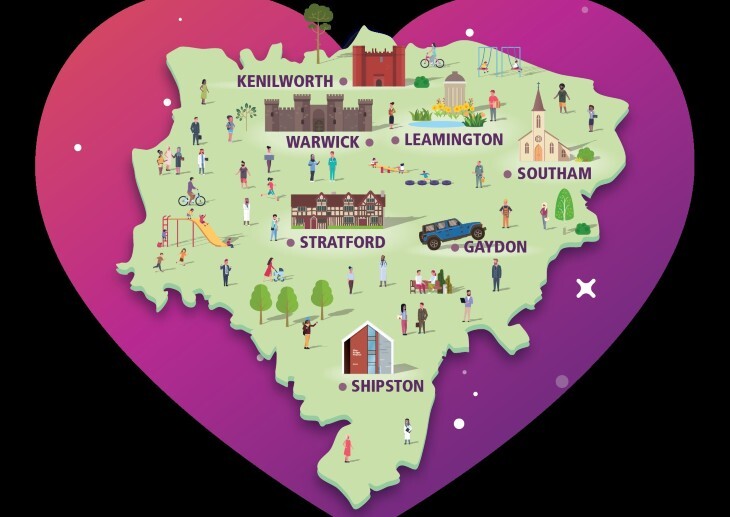Local authorities, NHS organisations and the voluntary sector have been working together as the South Warwickshire Place Partnership since 2020. Having navigated the complexities of shared decision-making, budget allocation and project leadership, we have successfully launched a series of preventative and highly targeted health and wellbeing interventions that are tackling the wider determinants of health and improving outcomes for some of our most vulnerable citizens.
Establishing Place priorities
The South Warwickshire Place Partnership was formally set up in 2021, building on the Warwickshire Health and Wellbeing Board’s 2018 strategy and in anticipation of Integrated Care Systems being developed. Our aim is to take a place-based approach to preventing ill health and reducing inequalities, informed by local population health needs.
Drawing on a combination of the Joint Strategic Needs Assessment and population health data, we agreed a vision centred on communities working together to enable everyone to be supported to live well and have safe and fully active lives, with a specific focus on at-risk groups:
- Children and Young People with support needs
- Older People on a low income
- People at risk of rural poverty
We identified three priorities: cost of living, mental health and wellbeing, and climate change, recognising the potential impact of these areas on all our communities but particularly those most at risk of inequalities.
Addressing funding and governance challenges
Despite the existence of health inequalities, particularly around rural isolation and access to services only one area within South Warwickshire falls within the 20% most deprived in England limiting access to external funding. With clear priorities and potential projects in mind, the five largest place partners by organisation size – Coventry and Warwickshire NHS Partnership Trust, Warwickshire County Council, Warwick District Council, Stratford-on-Avon District Council and South Warwickshire University NHS Foundation Trust – all committed to contribute £20,000 each year for five years (subject to annual budget reviews). South Warwickshire GP Federation also committed HR and clinical support for place projects. All partners have an equal share of voice, regardless of financial input or size.
It is this bold commitment that has enabled us to design and deliver targeted projects which align to both place and system priorities. Projects are set up as ‘start up’ initiatives to test and learn from with a view to securing mainstream funding if successful.
We drive all activity through a place delivery group which reports into our Place Partnership Board. Both groups have representatives from each of our partners, who are empowered to take decisions related to the partnership so that projects can be implemented quickly and effectively.
Both the Delivery Group and Board are sighted on relevant discussions and initiatives from the wider system, including the Health and Wellbeing Board, Primary Care Board and Care Collaborative, reducing duplication and enabling timely response to policy changes. A small, dedicated project support team coordinates activity, ensuring place projects remain front of mind alongside individual organisational pressures.
Outcomes
We are now implementing several projects with early signs of positive impact.
- In Lillington East, a Core20Plus locality, we combined ICB and Place funding to deliver a highly targeted respiratory health scheme which has just been extended to spring 2026. We have appointed a ‘community connector’ who works directly with eligible residents and those experiencing homelessness via the local Primary Care Network (PCN) to improve detection and prevention of respiratory disease. Through a combination of one-to-one support, community group engagement and social prescribing, we’ve seen an increase in Covid and flu vaccine uptake, smoking cessation referrals, physical activity referrals and increased uptake of wellbeing services. The community connector has also helped resolve housing and mobility issues that were contributing to ill health.
- Our Children and Young Person Mental Health Care Coordinators project is bridging the gap between GP referral and Child and Adolescent Mental Health Service (CAMHS) assessment, to support patients across the two PCN areas with highest need, and reduce A&E attendances. We provide structured support, signposting and mental wellbeing tools for children and young people across six sessions. Of the eligible patients identified, the team is currently supporting 42 individuals and families and has discharged five following successful completion of the programme. Short Warwick-Edinburgh Mental Wellbeing Scale (SWEMWBS) scores have improved by 3-5 points for discharged patients.
- Drawing on the combined skills and resources of partners and the voluntary sector, we’re funding green social prescribing for neurodiverse adults and patients with long-term conditions, of which over 60% have seen improvements in their SWEMWBS scores since launch.
Working collaboratively has helped identify and refine projects, drawing on expertise from the voluntary sector and incorporating the patient voice through Healthwatch. It’s also enabled us to free blockages. For example, through appropriate data sharing agreements, SWGP Federation is providing health eligibility verification on behalf of GPs for our Eco4 grants project tackling the cost of living and the risk of cold-related illnesses. This enables the project to progress more quickly and reduces the burden on GPs.
Beyond specific projects, the Partnership has and continues to be engaged in looking into the future of the health of the communities in South Warwickshire given significant changes in the level and rate of population growth, new housebuilding and the necessary infrastructure to support it. This has seen partner health organisations engage much more closely in the council-led Local Plan process, so that active health prevention can be built into new developments and that local health service infrastructure matches the likely population changes and new developments in South Warwickshire for the next 25 years.
Learning and next steps
Critical to the ongoing success of this partnership has been securing dedicated funding from partners to fund specific initiatives, which support health and wellbeing priorities identified through JSNAs and population health data.
We’ve also learnt quickly from projects that were either too complex or resource-hungry, giving us a good insight into where we can deliver most value.
Our Place Partnership projects closely align with the focus on neighbourhood health and preventative care in the new NHS 10 Year Plan which enhances the potential for successful Place-funded start-up projects to secure mainstream funding and we’re actively working as a partnership to develop new opportunities to support South Warwickshire Place.
South Warwickshire Place Partnership is made up of Warwickshire County Council, South Warwickshire University NHS Foundation Trust, Coventry and Warwickshire NHS Partnership Trust, Warwick District Council, Stratford-on-Avon District Council, South Warwickshire GP Federation, GP representatives, Warwickshire Community and Voluntary Action and Healthwatch Warwickshire.
By Chris Elliott, CEO, Warwick District Council, Adam Carson, Acting CEO, South Warwickshire University Hospital Trust, and Cristina Ramos, Chair, South Warwickshire GP Federation




